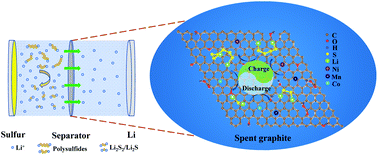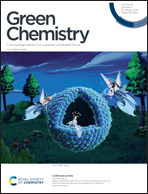The direct application of spent graphite as a functional interlayer with enhanced polysulfide trapping and catalytic performance for Li–S batteries†
Abstract
Recycling and reusing spent graphite have become urgent tasks, with massive numbers of lithium-ion batteries (LIBs) from hybrid electric vehicles (HEVs)/electric vehicles (EVs) retired every year. Meanwhile, interlayer designs based on carbon materials have attracted widespread attention to suppress the polysulfide shuttle effect in high-energy-density lithium–sulfur (Li–S) batteries. Nevertheless, designing simple and low-cost carbon-derived interlayers still remains a great challenge. Spent graphite possesses a porous structure, defects, and polar functional groups that were formed in situ, which can significantly confine polysulfides through a combination of physical and chemical adsorption. Meanwhile, transition metals introduced due to the dissolution of cathode active materials can also anchor polysulfides via S–TM bonding, as well as improving electrical conductivity and boosting polysulfide conversion kinetics. Herein, spent graphite recycled from waste LIBs was employed for the first time as a functional interlayer for Li–S batteries based on its intrinsic properties. The spent-graphite-derived interlayer exhibited remarkably enhanced trapping and catalytic performance toward polysulfides. A high discharge capacity of 968 mA h g−1 with a low decay rate of 0.08% per cycle over 500 cycles at 1 C can be obtained. The present work not only provides a promising strategy for the design of interlayers, but it also shows a high-value application of spent graphite.



 Please wait while we load your content...
Please wait while we load your content...